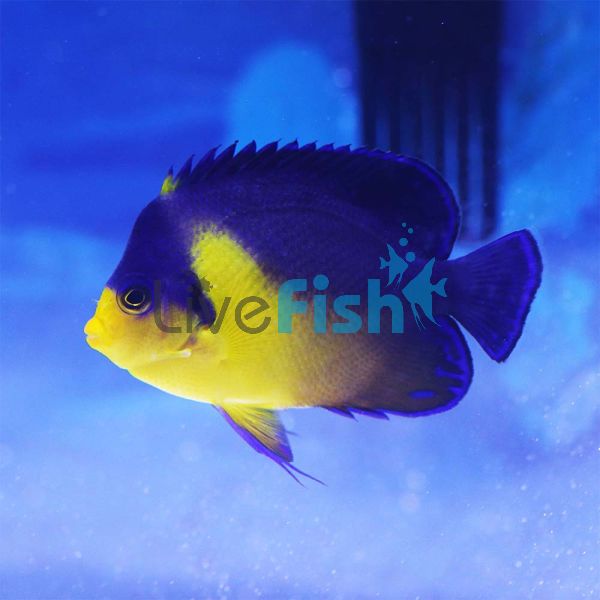Purple Mask Angelfish - Medium
With its beautiful bright yellow body, along with the purplish/blue triangular patch over the eye and saddle across the back. This fish makes an unusual addition that is sure to draw attention and spark conversation around any home aquarium.
The Venustus Angelfish is a shy animal in general and is one of the rare species that is becoming more widely available in the industry. Typically found in caves and on steep reef slopes.
This lovely and somewhat uncommon dwarf angelfish has a yellow body and face area. It has a triangular blue patch on top of the head, and a blue saddle area that begins near the front dorsal fin and extends over the rear portion of the body and caudal fin. The anal and pelvic fins are blue-edged.
All Centropyge species begin life as unsexed individuals but mature into females. The larger or more dominant individual within small groups will change sex and become a male within a few days to a couple of weeks. Knowing that size, rather than colour, is the primary difference between the sexes, all that is required is to juxtapose a small and larger specimen. Within sixty days, one of the two fish will have physically switched sexes to accommodate the other. If the need arises, this sex change can be reversed.
Keep in mind that all Angelfish have cheek spines at the edge of their gill cover. So use caution when handling and avoid capturing it with a net, as it may become stuck or tangled in the net and become damaged when removed.
The Purple Masked Angelfish can be found from Japan to the northern Philippines. It usually can be found in and around ledges and caves on steep outer reef slopes to depths of 40 meters (131ft). This is a shy species that is usually seen alone but is sometimes seen in pairs or small harems, often resting upside down inside a sheltered cave.Tank Recommendations for Purple Mask Angelfish
Even though little is known about its exact diet and aquarium care, it should undoubtedly mimic that of other deepwater species because it is normally found in caves. As a result, it is best to keep this species in well-established aquariums.
These fish are not suitable for small nano-style aquariums. This is because they will become very aggressive in small aquariums. Also, they will be unable to find enough food to be maintained long-term without numerous feedings per day.
Aquariums of at least 70 gallons (265 litres) are recommended. There should also be plenty of live rock to provide it with caves and crevices to explore and/or hide in when threatened.
Angelfish raised in captivity can tolerate a wide range of water temperatures, though they prefer slightly warmer water. The pH should be between 6.8 and 7.8, and the hardness should be between 3° and 8° dKH (54 to 145 ppm). It is best to keep the temperature between 78° and 84° F (25.6° -28.9 ° C).
These fish need clean water with a good filtration system. Performing 10% weekly or 25% every other week water changes with an Aqueon Aquarium Water Changer or Siphon Vacuum Gravel Cleaner is recommended. Before refilling your tank, remember to treat the tap water with Aqueon Water Conditioner!
Suitable Tank Buddies
It's best to keep only one species of this dwarf angelfish genus in the aquarium because they can become aggressive toward other dwarf angelfish. It should also be the last fish added because it can be quite feisty with newcomers.
Nonetheless, when first entering the aquarium, it can be quite shy and will hide in caves and crevices. However, as time goes on, it will become more outgoing and will begin to establish its territory.
Usually Compatible
While angelfish are generally peaceful, they can be aggressive toward one another, particularly when attempting to pair off and spawn. Other fish that are usually compatible are Damselfish, Clownfish, Tangs and Gobies. Most smaller fish that aren't overly aggressive are compatible such as Cardinals and Butterflyfish.
Sometime Compatible
Angelfish may tend to nip clam mantles, yet does fairly well with large and small polyped stony (LPS and SPS) corals. They are compatible with other dwarf Angelfish providing they don't look too similar.
Rarely Compatible
Pipefish and sea horses are rarely compatible with Angelfish. This is because they will be competing for the same food source and so so the Pipefish and Sea Horses may become stressed or starve. Also keeping them with sharks is also a bad idea as the sharks will view them as a tasty treat.
Feeding your Purple Mask Angelfish
The Venustus Angelfish is very picky about what it eats. It naturally eats sponge material in the wild. With time, patience, and careful acclimation to aquarium life, it can be taught to consume frozen and prepared foods. Because it is a shy fish at first, special care must be taken to teach it to accept strange new foods. To begin, feed a mixture of Angelfish Formula containing sponge matter as well as frozen mysis shrimp and spirulina.
Spirulina and marine algae and meaty fares such as vitamin/Spirulina-enriched brine shrimp, Mysis shrimp, special sponge-based Angelfish preparations, and finely chopped krill/squid/cockle/mussel, should be offered. Feed small amounts three times a day.
| Scientific Name | Centropyge venusta |
|---|---|
| Care Level | Hard |
| Common Names | Purple Masked Angelfish, Blue-Backed Angelfish, Purplemask Angelfish |
| Diet | Omnivore |
| Fish Family | Pomacanthidae |
| Lifespan (years) | 6 |
| Max. Length (cm) | 13 |
| Min. Tank Volume (l) | 500 |
| Origin | Western Pacific Ocean: Southern Japan, Taiwan and Ryukyu Islands, and the Philippines. |
| Reef Safe | With Caution |
| Sociability | Semi-aggressive |
| Venomous | No |
| Water Conditions | 72 - 81°F (22 – 27°C). Specific Gravity: 1.020-1.027 pH 8.0-85 |




